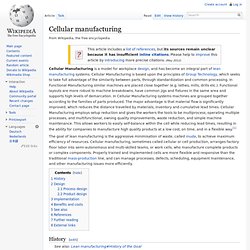

Manufacturing Systems. Manufacturing Systems Learning outcomes By the end of this section you should have developed a knowledge and understanding of: One-off, batch and high-volume productions systems Modular/cell production systems Just-in-time manufacture Brought-in parts and components, standardised parts The implications of these industrial production processes/procedures.

Introduction The main categories of manufacturing systems involve production processes that are one-off, batch and high volume. The type of product Demand for the product Capital Premises Tooling Labour skills One-off, batch and high-volume productions systems One-off production One-off production refers to the manufacture of a single component or product. Large-scale products such as ships, bridges and specialist stadium constructions Smaller-scale products such as jewellery, specialist furniture and bespoke clothing (suits and wedding dresses for example) Key points Batch Production Key Points High-Volume Production Just-in-Time Manufacture.
Cellular manufacturing. Cellular Manufacturing is a model for workplace design, and has become an integral part of lean manufacturing systems.

Cellular Manufacturing is based upon the principles of Group Technology, which seeks to take full advantage of the similarity between parts, through standardization and common processing. In Functional Manufacturing similar machines are placed close together (e.g. lathes, mills, drills etc.). Functional layouts are more robust to machine breakdowns, have common jigs and fixtures in the same area and supports high levels of demarcation. In Cellular Manufacturing systems machines are grouped together according to the families of parts produced. The major advantage is that material flow is significantly improved, which reduces the distance travelled by materials, inventory and cumulative lead times. History[edit] Cellular Manufacturing is the application of the principles of Group Technology in manufacturing.
Design[edit] Process design[edit] Product design[edit] Black, J. Risk management: Five steps to risk assessment. This is not the only way to do a risk assessment, there are other methods that work well, particularly for more complex risks and circumstances.

However, we believe this method is the most straightforward for most organisations. Follow the five steps in our leaflet: Five steps to risk assessment Don’t overcomplicate the process. In many organisations, the risks are well known and the necessary control measures are easy to apply. You probably already know whether, for example, you have employees who move heavy loads and so could harm their backs, or where people are most likely to slip or trip.
If you run a small organisation and you are confident you understand what’s involved, you can do the assessment yourself. Download the Risk Assessment and Policy Template [7]. If you work in a larger organisation, you could ask a health and safety adviser to help you. Step 1: Identify the hazards[9] Assembly line. An assembly line is a manufacturing process (most of the time called a progressive assembly) in which parts (usually interchangeable parts) are added as the semi-finished assembly moves from work station to work station where the parts are added in sequence until the final assembly is produced.

By mechanically moving the parts to the assembly work and moving the semi-finished assembly from work station to work station, a finished product can be assembled faster and with less labor than by having workers carry parts to a stationary piece for assembly. Assembly lines are the common method of assembling complex items such as automobiles and other transportation equipment, household appliances and electronic goods. Concept[edit] Assembly lines are designed for the sequential organization of workers, tools or machines, and parts. The motion of workers is minimized to the extent possible. According to Henry Ford: Simple example[edit] History[edit] Interchangeable parts[edit] 20th century[edit]